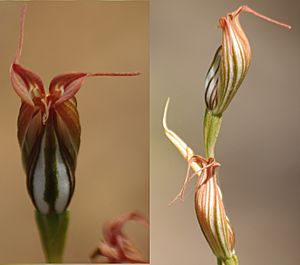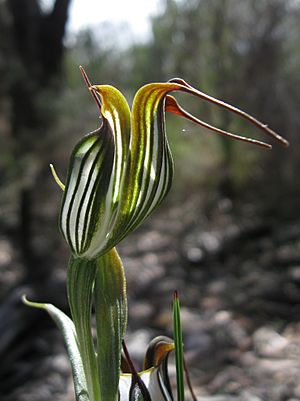Jug orchid facts for kids
Quick facts for kids Jug orchid |
|
|---|---|
 |
|
| Flowers of Pterostylis recurva | |
| Scientific classification | |
| Genus: |
Pterostylis
|
| Species: |
recurva
|
| Synonyms | |
|
Stamnorchis recurva (Benth.) D.L.Jones & M.A.Clem. |
|
The Jug orchid, also known as the recurved shell orchid, antelope orchid, or bull orchid, is a special plant from the orchid family. It grows only in the south-west part of Western Australia. This orchid is quite common and has beautiful white flowers that look like small jugs or funnels. They often have green and brown lines on them. If the plant isn't flowering, it will have a group of leaves shaped like a circle, called a rosette, on a short stem.
Contents
What the Jug Orchid Looks Like
The Jug orchid, or Pterostylis recurva, is a plant that grows from an underground tuber (like a small potato). It's a perennial plant, meaning it lives for more than two years. It's also deciduous, so its leaves fall off at certain times of the year, and it's a herb, meaning it has soft stems, not woody ones.
Leaves of the Jug Orchid
If the plant is not flowering, it has a rosette of leaves. This means the leaves grow in a circular pattern close to the ground. There are usually three to seven leaves in this rosette. Each leaf is about 7–40 mm (0.3–2 in) long and 5–15 mm (0.2–0.6 in) wide.
When the plant is flowering, it doesn't have a rosette of leaves at the base. Instead, it has ten to sixteen leaves growing along its stem. These stem leaves are about 30–50 mm (1–2 in) long and 10–12 mm (0.4–0.5 in) wide. Their bases wrap around the flowering stem.
Flowers of the Jug Orchid
The Jug orchid can have up to four white flowers with green and brown lines. These flowers grow on a stem that can be quite tall, from 150–900 mm (6–40 in) high. The flowers are shaped like a jug or a funnel. They are about 30–35 mm (1.2–1.4 in) long and 15–25 mm (0.6–1 in) wide.
The top part of the flower, called the dorsal sepal, and the petals form a kind of hood over the center of the flower. This hood is called a "galea." The dorsal sepal has a narrow tip that is about 4–6 mm (0.2–0.2 in) long. The two side sepals (called lateral sepals) are joined together for about half their length. They then suddenly become narrow tips, about 23–26 mm (0.91–1.0 in) long, which bend sharply downwards.
Inside the flower, there is a special lip-like part called the labellum. It is reddish and looks a bit like an insect. Most of the labellum stays hidden inside the flower, with only its very tip showing. The Jug orchid flowers between August and October.
How the Jug Orchid Got Its Name
The scientific name for the Jug orchid, Pterostylis recurva, was first officially described in 1873. This was done by a scientist named George Bentham. His description was published in a book called Flora Australiensis.
The second part of the name, recurva, is a Latin word. It means "bent backward." This name was chosen because the side sepals of the flower bend sharply downwards, looking like they are bent backward.
Where the Jug Orchid Grows
The Jug orchid is found in many different types of places. It grows in woodlands, shrublands, and forests. You can also find it in shallow soil on top of granite rocks. It can grow in various types of soil, including sand, clay, laterite (a type of soil rich in iron and aluminum), and gravel. This orchid is common and can be found across a wide area between Geraldton and Israelite Bay in Western Australia.
Protecting the Jug Orchid
The Western Australian Government's Department of Parks and Wildlife has looked into the status of Pterostylis recurva. They have officially classified it as "not threatened." This means that currently, there are enough Jug orchids, and they are not in danger of disappearing.


